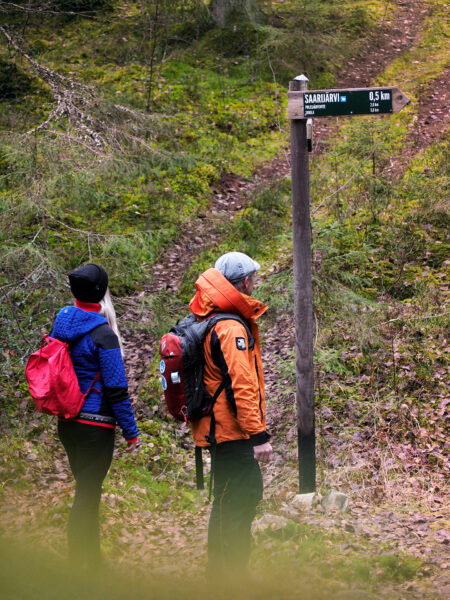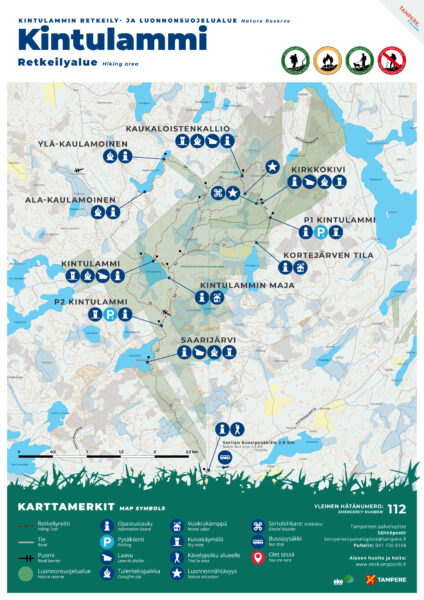Kintulammi hiking and nature reserve
Lis
- Kintulammi
- Routes and services
- Location and arrival
- Maps
- Nature and sights
Kintulammi
Kintulammi is a wonderful hiking and nature reserve located in Tampere, in the Teisko-Aitolahti area. It is an open-to-all nature and hiking destination with trails, boardwalks, shelters, and signposts. The area is located about 20 km from the centre of Tampere in the direction of Teisko.
The area has about 18 km of marked hiking trails and 6 campfire sites, four of which have a unique, naturally designed shelter complex with a woodshed and a dry toilet.
The Kintulammi nature reserve consists of three parts, with a total area of 608,5 hectares. Vattula forms the core of the area, which was protected in 1959, and its expansion area in 2003. The area of Vattula is 61 ha. The nature reserve was significantly expanded in 2017, when the Kintulammi hiking area was protected as part of the “Nature gift to Finland’s 100th Anniversary” campaign. Remember to leave no trace when walking in the area. Use boardwalks and trails, always keep your pets on a leash, and admire the plants without picking them.
Routes and services
The Kintulammi hiking and nature reserve has about 18 kilometres of marked hiking trails, which consist of several alternative loops. The trails are signposted with directional signs, which make hiking enjoyable and safe. The directional signs are made of reflective material.

Five different lean-to and campfire site complexes with woodsheds and dry toilets have been built in the area, as well as two campfire sites without a lean-to or toilet. All lean-tos and facilities are different and individually designed for their location. The Kirkkokivi lean-to serves as the so-called central facility of the area. The trail from the P1 parking area to Kirkkokivi has been designed and implemented as a barrier-free stone dust path. The barrier-free section is about 300 metres up to the Kirkkokivi lean-to.
Destinations
Ala-Kaulamoinen
Facilities: Campfire site, Woodshed, Information board
Kaukaloistenkallio
Facilities: Lean-to shelter, Campfire site, Woodshed, Dry toilet, Information board
Kintulammi
Facilities: Lean-to shelter, Campfire site, Woodshed, Dry toilet, Information board
Kintulammin maja
Facilities: Rental cabin, Information board
Kirkkokivi
Facilities: Lean-to shelter, Campfire site, Woodshed, Dry toilet, Information board, Accessible route (0,3 km)
Kortejärven tila
Facilities: Rental cabin, Information board
P1 Kintulammi (Kortejärvi)
Facilities: Dry toilet, Information board
P2 Kintulammi (Saarijärvi)
Facilities: Dry toilet, Information board
Saarijärvi
Facilities: Lean-to shelter, Campfire site, Woodshed, Dry toilet, Information board
Ylä-Kaulamoinen
Facilities: Campfire site, Woodshed, Information board
Location and arrival
The Kintulammi nature reserve is located in Teisko-Aitolahti, about 20 kilometers northeast of the center of Tampere.
By car
To reach the area from Tampere, turn onto Pulesjärventie from the Aitolahti-Sorilan intersection. From Pulesjärventie, turn either onto Kintulammentie (P2 – on the map) or Keltolahdentie (P1 – on the map) to reach the parking areas. When heading for the Keltolahdentie (P1) parking area, it is a good idea to put the address Keltolahdentie 47 into your navigation system. When heading to the Kintulammentie parking area, a good address for your navigation system is Kintulammentie 378. Please note that the parking areas are limited and the roads leading to the area are narrow. There are passing places on the roads. Therefore, please be careful when arriving at the area.
By public transport
The Nysse bus line 90 operates 1-2 times per hour to the Sorila bus stop number 5218. The distance from the stop to the access trail leading to the area is about 3 kilometres by walking along Pulesjärventie. It is also possible to turn off at the Kintulammentie intersection, which is about 1,6 kilometres from the bus stop. Pulesjärventie is quite a busy road with some heavy gravel truck traffic. For safety reasons, walking from the line 90 bus stop, especially with children or in large groups, is NOT RECOMMENDED.
On weekdays, there is a connection from Sorila (bus line 92) to the southern end of the Kintulammi trail according to the schedule at www.nysse.fi/en/schedules-and-routes/lines.
By bike
The area is perfectly reachable by bicycle. The Lake Trails cycling routes pass through Teisko in the immediate vicinity of the area. The ‘Viitapohjan loop’ along Pulesjärventie is particularly popular among cyclists. It is possible to cycle from the centre of Tampere along cycling paths all the way to the Aitolahti-Sorila intersection. From this intersection, it is about 1,6 km along Pulesjärventie to the turn onto Kintulammentie (P2) leading to the area.
Maps

Kintulammin retkeily- ja luonnonsuojelualue (TRE_L201 – pdf)
See more map information by clicking the Map link in the upper left corner.
Nature and sights
Kintulammi is a valuable, extensive, and cohesive natural area. It contains various types of forests, as well as marshes, rocks, lakes, and small bodies of water. Kintulammi is the third-largest protected forest area in Pirkanmaa, following Seitseminen and Helvetinjärvi National Parks. It is a nationally significant and valuable region. The forests in the area were previously used for economic purposes, but in practice, clear-cutting, for example, has not been done for decades as the area has been designated for recreational use. The forests vary in age and degree of naturalness, but the majority are mature or old. The most common forest types are fresh pine forest (blueberry type) and dry pine forest (lingonberry type). In some places, there is already a considerate amount of deadwood that is important for biodiversity, and it will increase as forests age and become more natural. Kintulammi also has marshes, most of which have been drained in the Finnish tradition for forestry. The first drainage operations were carried out in the mid-1940s. The largest marshes in the area, Laukkisuo and Ruutanansuo, have been drained, but smaller mires and fens have been preserved undrained.
The distinctive feature of the forests in Kintulammi are the ancient, massive, pines, known as ‘aihki.’ The oldest of them are up to 300–400 years old, which means that they may have been young trees in the mid-1600s when Queen Christina ruled over Finland alongside Sweden. Aihki pines are typical of former royal parks, which most of the Kintulammi area used to be. The mightiest of them is in the old, protected nature reserve of Vattula, but a pine protected as a natural monument northeast of the Saarijärvi lake, and a few others come close. Thanks to their thick bark, aihki pines have survived past forest fires, but the fires have often left their marks on their bases as charred remnants. Old fire scars in various parts of the area also indicate that forest fires occurred more frequently in the past. Nowadays, forest fires are rare, but there is a relatively small area in the western part of the Kintulammi area that burned in 2010. Burned and charred wood, like deadwood, is crucial for the biodiversity of the forests.
The biodiversity in Kintulammi includes many species typical of old forests and those that thrive in extensive, cohesive forests. The wood grouse is just such a species, and Kintulammi is one of its strongest habitats in Pirkanmaa. Other examples of species in the area include the Eurasian three-toed woodpecker, flying squirrel, and moor frog. There are few rarities among the plants, but regionally endangered orchid species, such as the lesser twayblade and the frog orchid, grow in the area. On the other hand, many demanding and rare species live on deadwood, like the regionally endangered pink polypore and the Rhodonia placenta.
With the designation as a nature reserve, the area is allowed to develop mostly in its natural state, and allow for its ecological values to improve. In Kintulammi, parts of the forests are restored through methods like controlled burning and felling to produce decaying wood. Restoration aims at returning the area to a more natural state and promoting natural developmental processes. In the forests, the goal is to maintain a continuum of decaying wood and natural fire processes. For the marshes, restoration involves practical measures like damming and/or filling ditches, allowing dried-up marshes to rehydrate. Partly undrained marshes like Kylmäsuo and other smaller ones will be restored in the coming years. While exploring the area, one can ponder how the forests and marshes might look and sound like centuries from now.
In the area, you can get to know or come across, among other things, the following:
Flying squirrel
With a bit of luck, you can see a flying squirrel gliding from tree to tree in the eastern part of the area during twilight. It nests in a hole made by a woodpecker in a birch trunk or in a twig nest in the shelter of a dense pine.
Wood grouse
Our largest grouse, the wood grouse, which needs extensive forest areas, thrives in Kintulammi.
Aihki
The old and huge pines have been growing in the area for many human generations. These venerable trees are truly majestic sights that tell a story from centuries ago.
Lesser Butterfly-orchid
A protected species of orchid, the Lesser Butterfly-orchid grows relatively abundantly in the area.


